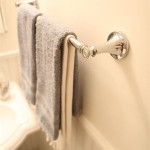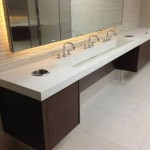How To Clean Dirty Bathroom Mirrors
Bathroom mirrors, often subjected to splashes, streaks, and residue from daily activities like showering, shaving, and applying makeup, tend to accumulate grime. Effectively cleaning these mirrors requires a systematic approach and appropriate tools to achieve a streak-free, clear surface. This article provides a comprehensive guide on cleaning dirty bathroom mirrors, covering various methods and techniques suitable for different levels of dirt and grime accumulation.
Preparation is Key: Gathering Supplies and Assessing the Mirror's Condition
Before initiating the cleaning process, gathering the necessary supplies is crucial. Essential items include:
- Cleaning solution: Options range from commercial glass cleaners to homemade solutions.
- Spray bottle: For even distribution of the cleaning solution.
- Microfiber cloths: These are preferred over paper towels as they minimize streaks and lint.
- Squeegee (optional): A squeegee can be used for a professional, streak-free finish, especially on large mirrors.
- Warm water: Useful for rinsing and diluting cleaning solutions.
- Vinegar (optional): White vinegar is a natural cleaning agent that effectively cuts through grime.
- Rubbing alcohol (optional): Isopropyl alcohol can help dissolve stubborn hairspray or makeup residue.
- Cotton swabs or cotton balls (optional): For cleaning edges and hard-to-reach areas.
- Protective gloves (optional): To protect hands from cleaning solutions.
Once the supplies are assembled, assess the condition of the mirror. Identify the type and severity of the dirt or stains present. Common issues include water spots, toothpaste splatters, hairspray residue, and general dust accumulation. Understanding the nature of the grime will inform the choice of cleaning solution and method.
Consider any special features of the mirror, such as a frame or decorative elements. These areas may require different cleaning approaches to avoid damage. For example, a wooden frame should not be excessively exposed to moisture.
Effective Cleaning Methods: From Commercial Cleaners to DIY Solutions
Several cleaning methods can be employed to clean bathroom mirrors, each with its advantages and disadvantages. The choice of method depends on personal preference, the severity of the grime, and the availability of cleaning supplies.
Commercial Glass Cleaners: These products are readily available and formulated specifically for cleaning glass surfaces. They typically contain solvents and detergents that effectively remove dirt and grease. When using a commercial glass cleaner, spray a light mist onto the mirror surface, avoiding oversaturation. Wipe the mirror with a clean microfiber cloth, using overlapping strokes. If streaks persist, turn the cloth to a dry, clean section and buff the mirror until it is clear. Ensure the cleaner is specifically designed for mirrors to prevent damage to the reflective coating.
Vinegar and Water Solution: A mixture of equal parts white vinegar and water is a cost-effective and environmentally friendly cleaning solution. Vinegar's acidity helps dissolve hard water stains and soap scum. Pour the solution into a spray bottle and apply a light mist to the mirror. Wipe the mirror with a microfiber cloth, using a circular motion to loosen grime. Follow with a clean, dry microfiber cloth to remove any remaining residue and buff the surface to a streak-free shine. The vinegar scent will dissipate quickly.
Rubbing Alcohol Solution: For mirrors with stubborn hairspray or makeup residue, a solution of rubbing alcohol and water can be effective. Mix one part rubbing alcohol with one part water in a spray bottle. Apply the solution to the affected areas and let it sit for a few seconds to dissolve the residue. Wipe the mirror with a microfiber cloth, using a gentle scrubbing motion. Follow with a clean, dry microfiber cloth to remove any remaining residue and buff the surface to a streak-free shine.
Dish Soap Solution: A mild solution of dish soap and water can also be used to clean bathroom mirrors. Add a few drops of dish soap to a bucket of warm water and mix well. Dip a microfiber cloth into the solution and wring out the excess water. Wipe the mirror with the damp cloth, using a circular motion to loosen grime. Rinse the mirror with clean water to remove any soap residue. Dry the mirror with a clean, dry microfiber cloth, buffing the surface to a streak-free shine. Ensure that all soap residue is removed to prevent streaking.
Shaving Cream: While unconventional, shaving cream can be used to prevent fogging on bathroom mirrors. Apply a thin layer of shaving cream to the mirror and let it sit for a few minutes. Wipe the shaving cream off with a clean, dry microfiber cloth. This leaves a protective layer that prevents condensation from forming on the mirror during showers. This method does not necessarily clean existing grime but helps prevent future fogging.
Newspaper: While microfiber cloths are generally preferred, crumpled newspaper can be used to buff the mirror after cleaning with a solution. The ink in the newspaper acts as a mild abrasive, helping to remove streaks and leave a shiny surface. However, be cautious, as some newspaper ink can rub off, potentially staining surfaces. Test in an inconspicuous area first.
Techniques for a Streak-Free Finish: Mastering the Wipe and the Squeegee
Achieving a streak-free finish on a bathroom mirror requires more than just the right cleaning solution. The technique used to wipe and dry the mirror is equally important. Here are some tips for a streak-free finish:
Using Microfiber Cloths: Microfiber cloths are highly absorbent and have a unique weave that traps dirt and grime. Use clean microfiber cloths for both cleaning and drying. Fold the cloth into quarters to provide multiple clean surfaces. As one section of the cloth becomes dirty, rotate to a clean section. Avoid using the same dirty section to wipe the entire mirror, as this will only spread the grime around.
Wiping Technique: Use overlapping strokes when wiping the mirror. Start at the top of the mirror and work your way down, overlapping each stroke slightly. This ensures that no areas are missed. Avoid pressing too hard, as this can leave streaks. Apply gentle pressure and let the microfiber cloth do the work.
Drying Technique: After cleaning the mirror, use a clean, dry microfiber cloth to buff the surface. Use a circular motion to remove any remaining residue and buff the surface to a streak-free shine. Turn the cloth frequently to a clean section. If streaks persist, lightly dampen the cloth with water and repeat the buffing process. Avoid letting the mirror air dry, as this can lead to water spots.
Using a Squeegee: A squeegee can be used to achieve a professional, streak-free finish, particularly on large mirrors. After spraying the mirror with a cleaning solution, hold the squeegee at a slight angle and pull it down the mirror in a single, smooth stroke. Overlap each stroke slightly. Wipe the squeegee blade with a clean cloth after each stroke to remove any dirt or residue. Practice is required to master the squeegee technique, but it can produce excellent results.
Cleaning Edges and Hard-to-Reach Areas: Use cotton swabs or cotton balls dipped in a cleaning solution to clean the edges of the mirror and other hard-to-reach areas. These small tools can effectively remove grime and buildup from corners and crevices. Pay attention to the area where the mirror meets the frame, as this is a common area for dirt accumulation.
Preventing Streaks: Several factors can contribute to streaks on a bathroom mirror. Using too much cleaning solution can leave residue that causes streaks. Avoid oversaturating the mirror with cleaning solution. Using a dirty or worn-out microfiber cloth can also cause streaks. Always use clean microfiber cloths and replace them when they become worn. Hard water can also contribute to streaks. If you have hard water, consider using distilled water in your cleaning solution.
Addressing Stubborn Stains: For stubborn stains that do not come off with regular cleaning methods, consider using a stronger cleaning agent or a dedicated stain remover. Always test the cleaning agent in an inconspicuous area first to ensure that it does not damage the mirror. Allow the cleaning agent to sit on the stain for a few minutes to loosen it before wiping it away. Avoid using abrasive cleaners or scouring pads, as these can scratch the mirror surface.
By following these preparation steps, selecting the appropriate cleaning method, and employing effective techniques, bathroom mirrors can be effectively cleaned to a streak-free, clear shine, enhancing the overall appearance of the bathroom.

4 Effective Ways To Clean Your Mirror Calibre Cleaning

How To Clean A Mirror Like Professional Cleaner

How To Clean A Mirror Molly Maid Cleaning Tips
:max_bytes(150000):strip_icc()/uses-for-rubbing-alcohol-1389041-03-74e11d833d7a435d8f97d3805ca10ca7.jpg?strip=all)
How To Clean A Mirror Like Pro

How To Clean A Bathroom Mirror Ctm
3 Easy Ways To Clean A Mirror

Cleaning Mirrors Karcher Singapore Private Limited

How To Clean A Mirror Like Professional Cleaner

How To Clean Water Stains On Mirror Easy Quick Method Kannada Kuvara

Cleaning Mirrors Kärcher International
Related Posts







